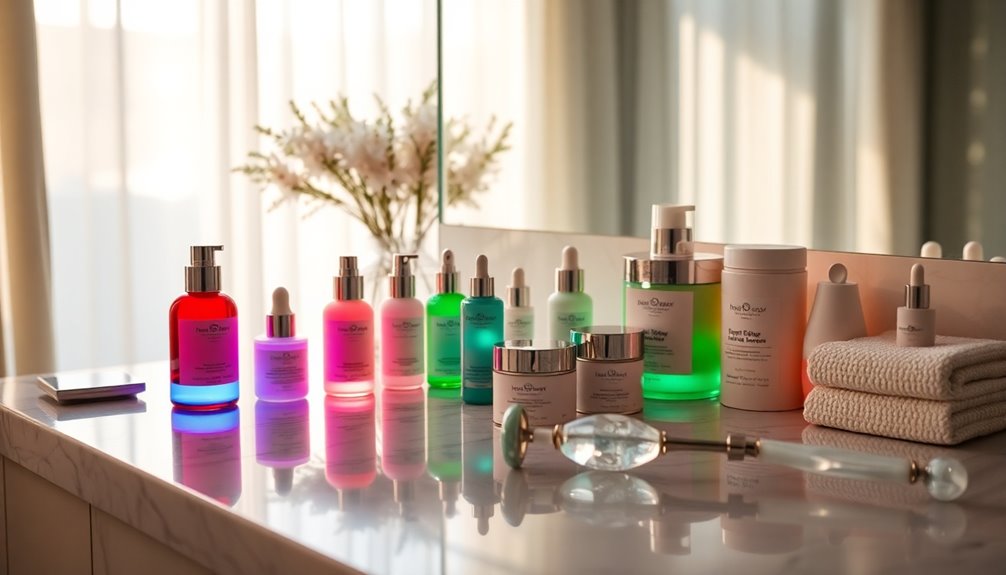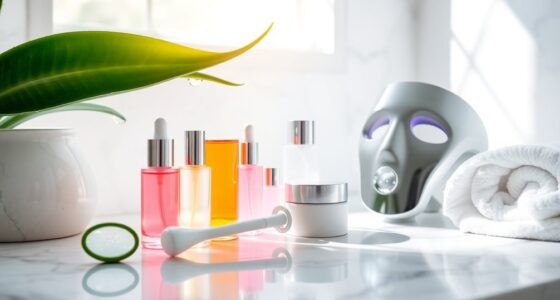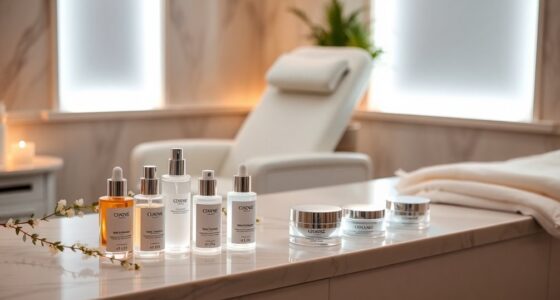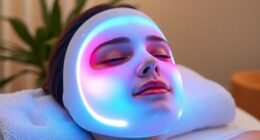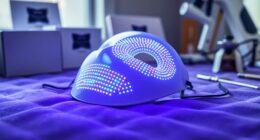To combine LED therapy with your skincare routine, start by identifying your skin concerns, like acne or aging. Choose the right wavelength—red for collagen, blue for acne, or near-infrared for deeper healing. Prep your skin with a gentle cleanser, then apply hyaluronic acid and peptides to enhance benefits. Utilize active ingredients like antioxidants and retinoids to boost your results post-therapy. Always monitor your skin’s response, noting any irritation or changes, and adjust your routine accordingly. Incorporating these steps can amplify your skincare’s effectiveness, and you’ll discover even more strategies to optimize your routine. After your LED therapy session, consider applying a nourishing moisturizer to lock in hydration and further support your skin’s recovery. Additionally, it’s essential to establish a consistent schedule; the best times for LED therapy often fall in the evening when your skin can benefit from overnight rejuvenation. Staying consistent with your treatments will lead to cumulative results, helping you achieve your skincare goals more effectively.
Key Takeaways
- Identify specific skin concerns like acne, aging, or hyperpigmentation to select the most effective LED therapy wavelength.
- Prepare your skin by cleansing, hydrating, and exfoliating before each LED treatment session for maximum effectiveness.
- Apply active ingredients like antioxidants and peptides after LED therapy to enhance results and promote skin healing.
- Monitor your skin's response to LED therapy and adjust your skincare routine based on any changes or sensitivities observed.
- Use FDA-approved LED devices and follow manufacturer guidelines to ensure safety and achieve optimal results.
Identify Your Skin Concerns
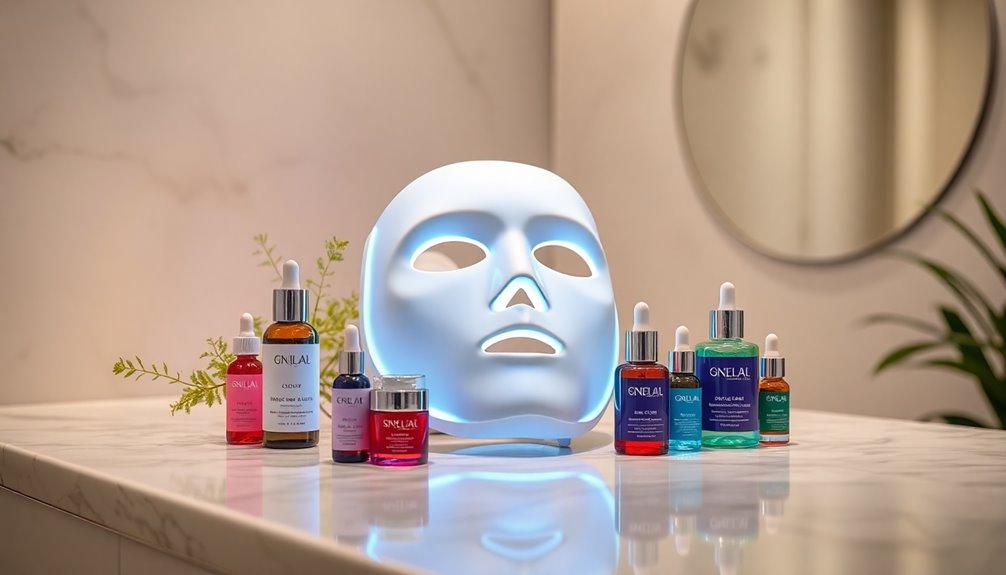
How well do you know your skin concerns? Identifying them is the first step to effective treatment.
If you're battling acne, look for symptoms like pimples and blackheads—blue light therapy can help. Regular use of LED therapy can significantly reduce the appearance of acne over time.
For aging skin, fine lines and wrinkles signal a need for red light therapy to boost collagen. This type of therapy enhances skin smoothness by stimulating collagen production.
Hyperpigmentation manifests as dark spots; blue light can even out your tone.
If dry skin's your issue, characterized by itchiness and flakiness, consider near-infrared light therapy for deeper healing. This therapy is known for its ability to penetrate deeper layers of the skin, promoting overall skin health.
Always be cautious: avoid certain products before therapy, especially if you're using Accutane or have skin conditions.
Understanding your specific concerns will guide your choice in combining LED therapy with your skincare routine effectively.
Choose the Right Wavelength

Choosing the right wavelength for LED therapy can significantly impact your skincare results.
For anti-aging, red light therapy (633nm to 670nm) boosts collagen production and reduces fine lines. Use it 3-5 times weekly for optimal benefits. Red light therapy is known for its ability to enhance circulation, which further contributes to improved skin health. Additionally, incorporating essential oils like lavender can complement the effects of red light by promoting relaxation and reducing stress, which can also benefit your skin.
If you're battling acne, blue light therapy (405nm to 450nm) effectively targets acne-causing bacteria and regulates oil production, making it perfect for daily use.
Near-infrared light (700nm to 850nm) penetrates deeper, reducing inflammation and promoting healing, typically used 2-3 times weekly.
For pigmentation issues, green light therapy (520nm to 560nm) can help break down excess melanin, also used 2-3 times weekly.
Choose the wavelength that aligns with your specific skin concerns for the best results.
Prepare Your Skin
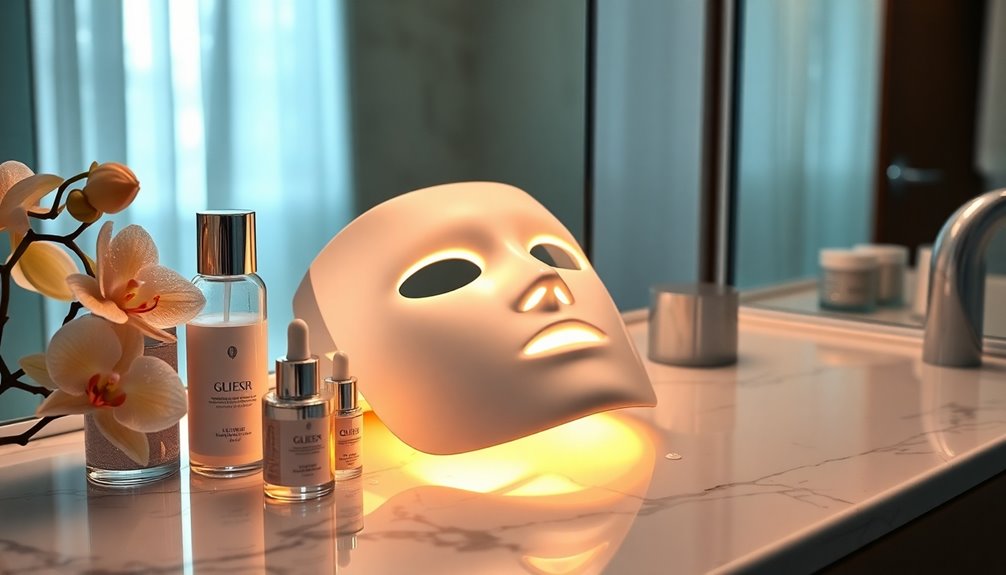
After selecting the right wavelength for your LED therapy, preparing your skin is key to maximizing the treatment's effectiveness.
Start by cleansing your face with a gentle, soap-free cleanser to remove dirt, sweat, and makeup. This ensures that the LED light can penetrate your skin without barriers. Cleanse both morning and night, but especially before your LED session.
Next, hydrate your skin with a hyaluronic acid serum, massaging it gently into the treatment area to lock in moisture and soothe any redness. Regular use of a hyaluronic acid serum can drastically improve your skin's hydration levels.
If you're exfoliating, use a mild enzyme powder cleanser to remove dead skin cells without irritation.
Finally, apply a peptide concentrate to enhance elasticity and minimize fine lines, setting the stage for optimal results from your LED therapy.
Apply Active Ingredients
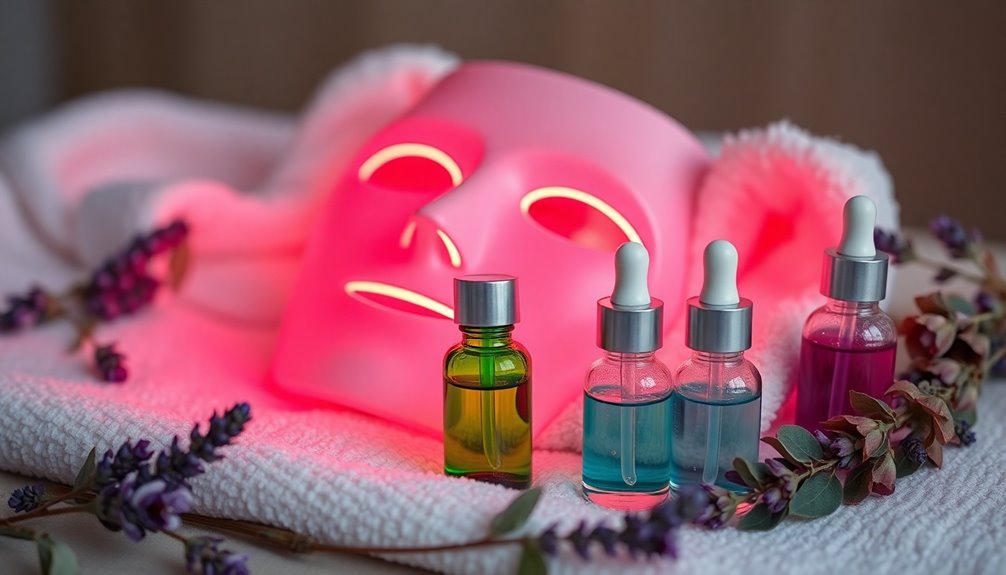
To maximize the benefits of your LED therapy, applying active ingredients immediately after your session is crucial.
Start with antioxidants like Vitamin C and Niacinamide to protect and brighten your skin, while also boosting collagen production. Incorporating antioxidants helps to protect against UV damage and enhances the effects of LED therapy.
Follow up with hydrating agents such as Hyaluronic Acid and Squalane to lock in moisture and improve elasticity.
Peptides and growth factors can further stimulate collagen, enhancing your skin's resilience.
If you're targeting texture, consider retinoids like Retinol, which promote cell turnover and reduce fine lines.
Finally, don't forget soothing agents like Aloe Vera or Centella Asiatica to calm any irritation.
Monitor Your Skin Response
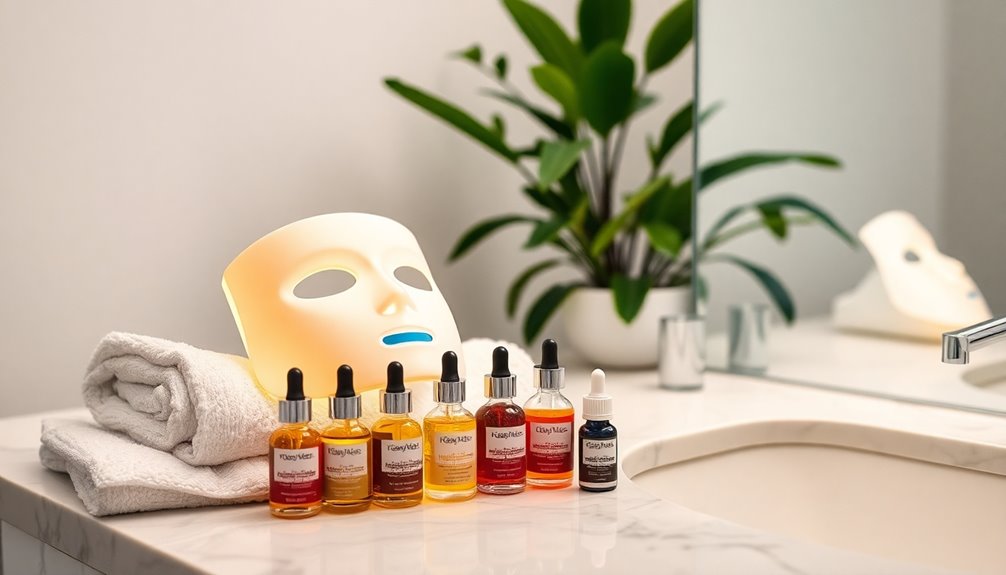
Applying active ingredients post-LED therapy can enhance your skin's rejuvenation, but it's equally important to monitor how your skin responds to each session. Pay attention to potential issues like redness, rash, or irritation. Track any changes and document your observations to assess progress effectively. If you notice unusual reactions, don't hesitate to consult a dermatologist for professional advice. Additionally, using products with glycolic acid can further optimize your results post-treatment.
Be prepared to adjust your routine based on your skin's feedback—common reactions can include increased sensitivity, dryness, and even acne flare-ups. Always use FDA-approved devices and follow the manufacturer's guidelines to ensure safety. Additionally, be mindful that LED light therapy can lead to improved skin health when used consistently and correctly.
Frequently Asked Questions
Can LED Therapy Be Used on All Skin Types?
Yes, LED therapy can be used on all skin types.
It's non-invasive and safe, making it suitable even for sensitive skin.
You'll find it helps promote circulation and enhance overall skin health, with minimal side effects like temporary redness.
Whether you have dry, oily, or combination skin, LED therapy can be customized to address your specific concerns, ensuring you get the most benefit while keeping your skin safe and healthy.
How Long Should Each LED Therapy Session Last?
"Good things come to those who wait."
For LED therapy, you should aim for each session to last between 10 to 20 minutes.
If you're focusing on maintenance, 10 minutes is sufficient.
However, if you're targeting specific skin concerns like wrinkles or hyperpigmentation, opt for the full 20 minutes.
Just remember, shorter sessions under 5 minutes mightn't deliver enough light energy to make a real impact on your skin.
Is LED Therapy Safe During Pregnancy?
Yes, LED therapy is generally safe during pregnancy, especially since it's non-invasive and doesn't use harmful UV rays.
However, you should consult your healthcare provider for personalized advice. It's wise to avoid direct abdominal application unless cleared by a professional.
Monitor your body's response, and if you feel any discomfort, stop using the device.
Can I Use LED Therapy With Other Skincare Devices?
Think of your skincare routine as a symphony, where each instrument plays its part beautifully.
Yes, you can use LED therapy with other skincare devices! Combining treatments like microdermabrasion or microneedling can enhance their effects and bring out your skin's best performance.
Just make sure to check for skin sensitivity and seek professional advice to create a harmonious blend that works for you.
Your skin will thank you for it!
Are There Any Side Effects of LED Therapy?
Yes, there are side effects of LED therapy you should be aware of.
You might experience temporary redness and irritation, dryness, or mild skin reactions. It's also possible to become more sensitive to sunlight, so wearing sunscreen is crucial.
In rare cases, allergic reactions or severe irritation can occur, especially if you don't follow usage guidelines.
Always monitor your skin's response and consult a dermatologist if you have existing skin conditions.
Conclusion
Combining LED therapy with your skincare routine can feel daunting, but it's simpler than you think. You're not just investing in a treatment; you're investing in your confidence and well-being. Don't let doubts hold you back—imagine the radiant skin you've always wanted! Embrace the journey, and remember that every step you take brings you closer to healthier, glowing skin. So go ahead, take the leap. You deserve to feel amazing in your own skin.
